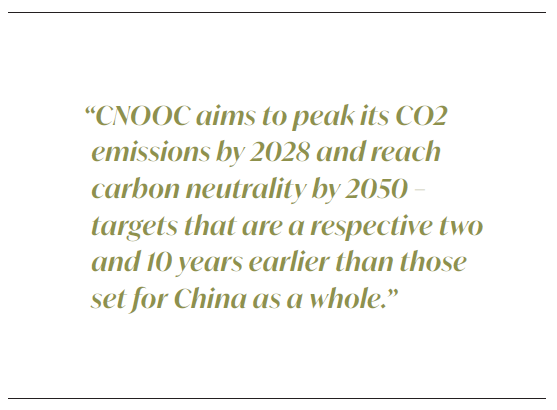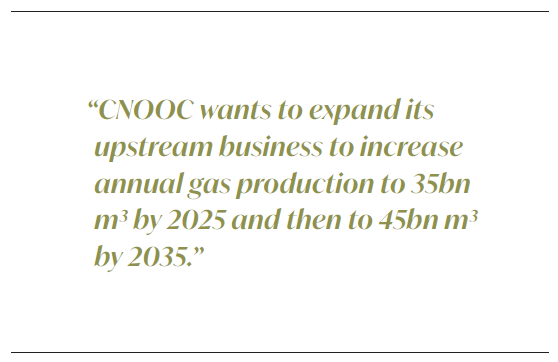CNOOC turns to gas and wind to power its climate efforts [Gas in Transition]
China’s biggest offshore oil and gas driller CNOOC is leaning on gas and wind power to build out its clean energy portfolio as the NOC looks to ramp up green developments to align with national climate goals over the second half of this decade.
CNOOC, China’s second-biggest oil and gas producer, is flush with cash after a so-called ‘homecoming’ listing in April, when it raised 28bn yuan ($3.9bn) through an initial public offering on the Shanghai Stock Exchange. This brought the NOC’s total market capitalisation to $65bn – making it the second-largest E&P player globally behind ConocoPhillips in terms of valuation.
The extra funding from this domestic share listing – along with improved free cash flow generation – is enabling CNOOC to accelerate its ESG focus and emphasis on the energy transition, with a focus on gas and offshore wind power this decade – a similar game plan to European oil majors such as BP and Equinor.
The energy transition has become increasingly important for China’s energy giants in recent years, especially after president Xi Jinping announced China’s net-zero target by 2060 back in September 2020. CNOOC aims to peak its CO2 emissions by 2028 and reach carbon neutrality by mid-century – targets that are a respective two and 10 years earlier than those set for China as a whole by President Xi.
As part of this decarbonisation drive, the Shanghai and Hong Kong-listed NOC has said it will boost capital expenditure on renewable energy to 5-10% per year by 2025, up from around 1% last year and rising to 10-15% in the second half of this decade. Based on CNOOC’s estimated investment budget of 90-100bn yuan for this year, 5-10% would be equivalent to an outlay of 4.5-10bn yuan/year in the next two to three years.
Much of this will go towards ramping up offshore wind power development, leveraging decades of technical expertise in offshore operations as it joins fellow majors at home and abroad in boosting renewable energy investment. Offshore wind is the main focus of CNOOC’s new energy portfolio, with the company aiming to have 1.5 GW of offshore wind capacity installed and commissioned by 2025 compared with 300 MW last year, along with 50-100 MW of onshore wind over the same period.
CNOOC launched its first offshore wind farm in September 2020 off the coast of eastern Jiangsu province in September 2020. The 300-MW capacity Zhugensha 2 project supplies 860,000 MWh of power to the grid annually, reducing CO2 emissions by 571,000 metric tons/year compared with a traditional coal-fired power plant with equivalent generation capacity.
This marked the entry point for the company’s exploration in the offshore wind space. In August 2021, CNOOC announced a second wind farm near the southern coastal city of Shantou in Guangdong province with a designed installed capacity of 1 GW.
Two months later it disclosed plans for a floating wind power project at the Wenchang oilfield in the South China Sea in cooperation with Norwegian offshore contractor Aker Solutions. This will comprise a semi-submersible floating wind platform with 6.25 MW turbines to be provided by Shanghai Electric that will provide electricity for the production platform at the Wencheng oil complex.
Then in early November 2022, CNOOC and ConocoPhillips China signed an agreement to start an offshore wind farm pilot project that will supply electricity to the Penglai oilfield in northeast China’s Bohai Bay, which is China’s largest offshore oil and gas production base under a production-sharing contract.
The windfarm will comprise four wind turbines with a total installed capacity of 34 MW and tie back to the existing central processing platform via subsea cables, distributing energy to the oilfield’s power grid system. The wind farm has enough capacity to potentially meet around 30% of the Penglai oilfield’s operational power needs.
Picking up wind
To be clear, CNOOC's offshore wind business is still at a nascent stage relative to its traditional fossil fuel business. The Zhugensha 2 wind farm is expected to earn 183mn yuan/yr of revenue for CNOOC, while the Shantou project will generate 748mn yuan/yr for the company once it comes online in 2027, according to industry analysts. This amounts to a combined 931mn yuan – less than 1% of CNOOC’s total revenue of 246bn yuan last year but still a step in the right direction.
In the long term the NOC aims to acquire offshore acreage that could host 5-10 GW of offshore wind capacity. It is also looking to hold an onshore portfolio with the potential capacity for 5 GW of onshore wind and solar, with plans to have between 500 MW and 1 GW installed and commissioned by 2025.
There is plenty of potential for CNOOC to hit its offshore wind targets and exceed them. The majority of China’s offshore wind farms are concentrated in the provinces of Jiangsu, Fujian, Guangdong, Shanghai, Zhejiang, Hebei and Liaoning. Among them, Jiangsu, Fujian, Guangdong, Zhejiang and Fujian have all set specific targets to further expand their offshore wind capacity.
For instance Jiangsu had 11.7 GW of subsidised grid-connected offshore wind power capacity at the end of last year, and wants to raise this to 15 GW by the end of 2025. Guangdong wants to nearly triple capacity over the same period, to 18 GW from 6.8 GW, while Zhejiang is looking to double capacity from 2.3 GW to 5 GW.
All in all China could add as much as 52 GW of new offshore wind capacity in 2022-2025, according to industry analysts at Credit Suisse.
Lean towards low-carbon gas
Even as it allocates some capital expenditure towards renewables, CNOOC remains primarily focused on plans to lift fossil fuels output to 600mn to 610mn barrels of oil equivalent in 2022, from 570mn barrels of oil equivalent last year.
 Gas provides an interim solution in the carbon neutrality pathway before the world reaches net-zero, given that it is a low-carbon energy source that emits 30-50% less CO2 than diesel and diesel. CNOOC’s gas production recorded a growth of 9.5% CAGR between 2018 and 2021, reaching 20bn m³ last year – equivalent to 20.5% of total oil and gas output.
Gas provides an interim solution in the carbon neutrality pathway before the world reaches net-zero, given that it is a low-carbon energy source that emits 30-50% less CO2 than diesel and diesel. CNOOC’s gas production recorded a growth of 9.5% CAGR between 2018 and 2021, reaching 20bn m³ last year – equivalent to 20.5% of total oil and gas output.
CNOOC aims to raise the share of gas in its output mix to 30% by 2025, although NGW understands that the company is internally optimistic of reaching 35%. The company wants to boost E&P to increase annual gas production to 35bn m³ by 2025 and then to 45bn m³ by 2035.
CNOOC currently has several large-scale gas projects under operation to support the upcoming acceleration. In June 2021 the Shenhai-1 project officially started up in the waters near the southern island province of Hainan. The project – CNOOC’s first solo-operated deep-water gas field – is expected to provide a stable supply of up to 3.4bn m³/yr and meet approximately one-quarter of gas demand in the Greater Bay Area, home to 86mn people.
Some of CNOOC’s biggest and most exciting discoveries recently have been made in deep-water frontiers. In October it announced the discovery of Baodao 21-1, its first deep-water deep-stratum play with proven reserves exceeding 50bn m³ in waters southeast of Hainan.
Besides offshore projects, CNOOC has also accelerated development of onshore unconventional gas – not its traditional area of development. CNOOC’s coalbed methane output jumped by 79.1% or 1.14bn m³ year-on-year to reach its production target of 3.59bn m³ in 2021, making the company the biggest onshore coalbed methane (CBM) producer in China.
CNOOC aims to lift onshore CBM output to 6-10bn m³/yr by the end of 2025. The NOC is moving forward with commissioning the Panhe thin-layer CBM development project, while building capacity at the Shenfu South gas field development and Central Linxing 4/5 development projects.
The company is also developing the Shen’an pipeline to facilitate CBM sales prospects. The pipeline has a capacity of 5bn m³/year and runs for 622.98 km from Shenmu city in Shaanxi province to Anping town in Hebei province, making it the longest CBM pipeline in China. The part between Shanxi and Hebei provinces has been gradually launched since July 2021 to supply about 600mn m³/yr.
Carbon capture in sight
CNOOC is also exploring carbon capture and storage (CCS) as it looks for further ways to apply its offshore technical capabilities. CNOOC signed a memorandum of understanding with Shell and ExxonMobil this summer to study the development of a world-scale offshore CCS hub in Guangdong that could capture 10mn mt/yr of CO2.
The agreement came days after the NOC launched China’s first offshore CCS demonstration project to serve the Enping 15- 1 oilfield in the South China Sea – up to 1.46mn mt of emitted CO2 during the oil extraction process will be sequestered over the field’s lifespan.
Although CNOOC has not provided specific targets for CCS, the demonstration project is likely to be extended to the Enping 10-2, 15-2 and 20-4 oilfields in the next few years, enabling CO2 emission reductions as well as enhanced oil recovery for the oilfields to achieve higher economic returns.



